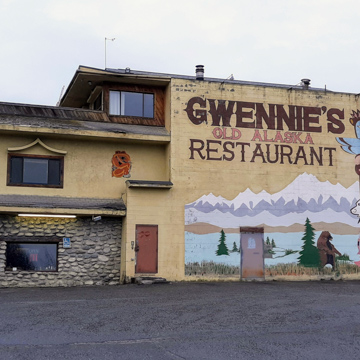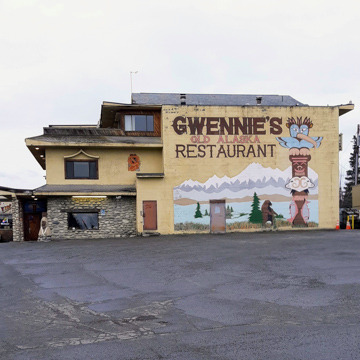Gwennie’s Old Alaska Restaurant is a longtime Anchorage restaurant within the Spenard neighborhood. Known for its large portions, all-day breakfast, and Alaskana décor, including dozens of pictures of the original Anchorage tent city and the aftermath of the 1964 earthquake, Gwennie's is among the neighborhood's most recognizable landmarks. A stylized mural depicting a totem pole and mountain scenery adorns the exterior. Before it assumed its current location, Gwennie’s occupied a smaller building at 2915 Spenard Road between 1974 and 1979. A second Gwennie’s location, Gwennie’s Bar-B-Cue, briefly operated in the mid-1970s at 341 Boniface Parkway on Anchorage's east side.
In 1979, Gwennie’s Old Alaska Restaurant relocated to its current location at 4333 Spenard Road, putting it at the center of one of Anchorage's most illustrious vice districts. There, Gwennie's took over space formerly occupied by the Pagoda Restaurant, one of Spenard's most colorful and storied buildings. The Pagoda Restaurant was a three-story building that held a spacious Chinese eatery with several notable design features. It mimicked aspects of Asian pagodas, including the curled eaves and a tiered structure. The windows, too, were built with curled eaves just above them. The building was completed in 1973 with eight hundred tons of stones from Granite Creek, composing much of the exterior wall of the restaurant's first floor as well as inside support columns. Once inside, one could drink at the bar or eat in the spacious dining room. The Pagoda Restaurant also featured two “fire-breathing” stone dragons at the front and an interior waterfall that fell from the second floor to a first-floor fishpond. The Pagoda, however, was known as much for its quirky architectural features as it was for hosting sex workers and serving as a brothel on its third floor. Thousands of young men arrived in Alaska to work on the construction of the oil pipeline during the mid-to-late 1970s. Many of these men stopped over or settled in Anchorage, flush with money and looking to spend it. Thus, Spenard, with its bars, clubs, and adult entertainment, came to symbolize the excesses of Anchorage's oil-boom era, and the Pagoda was among the most notorious spots.
By the time the Pagoda Restaurant became Gwennie’s in 1979, construction of the pipeline was coming to an end. The new owner, Ron Eagley, kept the decorative, curled eaves on the building's exterior but made several changes to distance the new restaurant from its former reputation. He had the two heads of the exterior stone dragons removed and replaced with carved walrus heads. The exterior received a new yellow paint job that included a totem to the side and a mountain range dominating the center of the wall. The entrance still faces Spenard Road, and a bar is off to the north end of the restaurant. Expanded dining comprises much of the rest of the building; the kitchen is also expanded, and the menu is typical of a family diner. The stone columns remain, but a series of taxidermied animals have been propped up throughout the dining room to conjure the Alaska wilderness and give patrons a rather memorable dining experience. The name of the restaurant is painted prominently on the south-facing wall. The result is a building that stands three stories and incorporates a mashup of faux Asian decor and homages to the Alaskan landscape and wildlife. It remains a popular restaurant among both locals and tourists alike.
References
“Opening Monday Gwennies Bar-B-Que advertisement.” Anchorage Times, August 14, 1976, 34.
Perala, Andrew. “Somethings Sort of Wild.” Anchorage Daily News, September 27, 1991, D10.
Toomey, Sheila. “Pagoda Awakes.” Anchorage Daily News, July 28, 2003, B1.

















